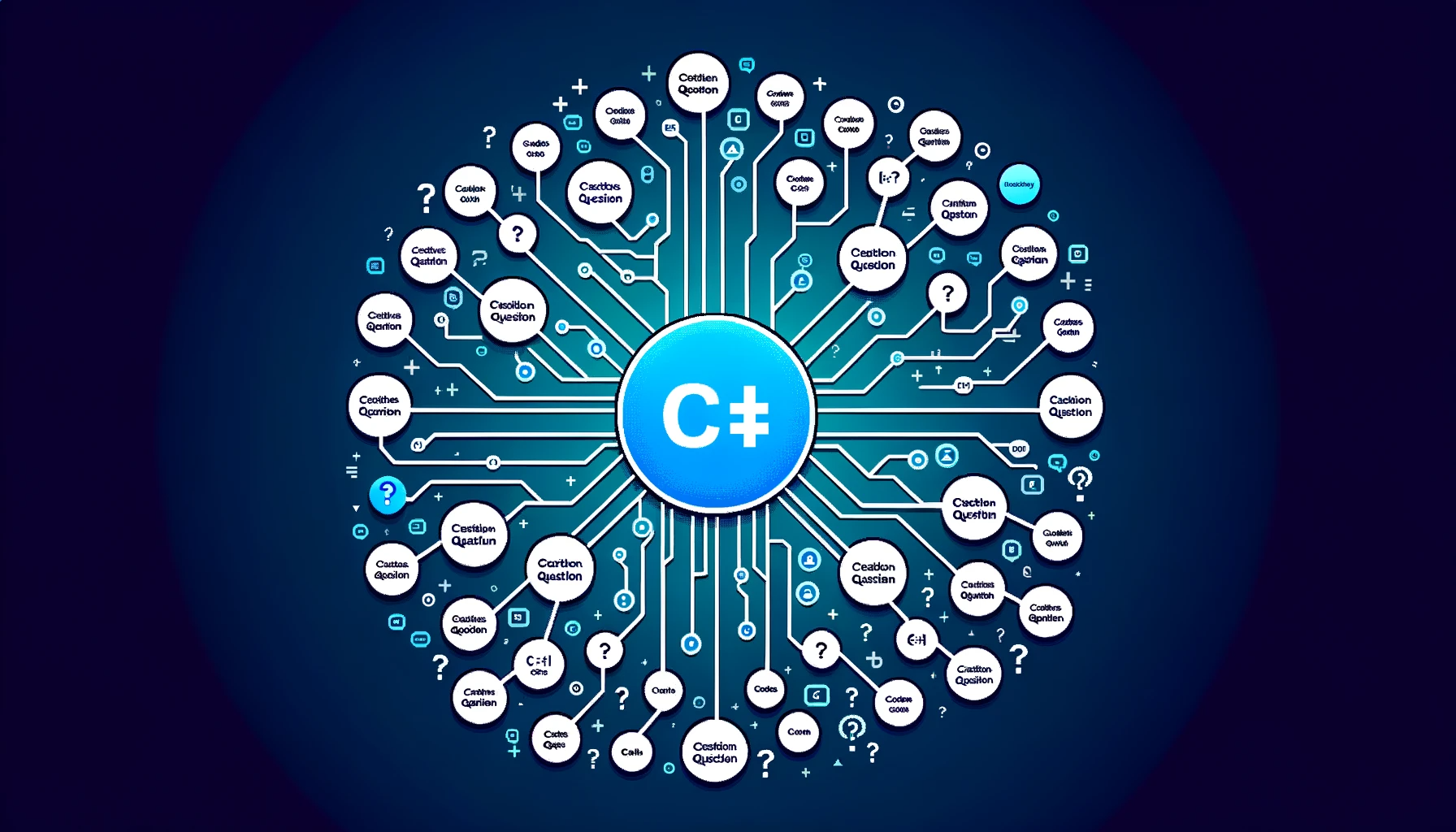
Here are 50 simple Javascript questions along with their answers and code examples:
- What is the output of
console.log(5 + "5")in JavaScript?- This will output
55. Because one operand is a string, JavaScript will convert the other operand to a string before performing the concatenation.
- This will output
- What is the output of
console.log(5 - "5")in JavaScript?- This will output
0. JavaScript performs type coercion and converts the string"5"to the number5, then does the subtraction.
- This will output
- What is the output of
console.log(5 == "5")in JavaScript?- This will output
true. The double equals==operator performs type coercion if the types on both sides are different.
- This will output
- What is the output of
console.log(5 === "5")in JavaScript?- This will output
false. The triple equals===operator does not perform type coercion.
- This will output
- Write a function to reverse a string in JavaScript.
function reverseString(str) {
return str.split('').reverse().join('');
}- How do you declare a variable in JavaScript?
var myVariable = "Hello"; let myVariable = "Hello"; const myVariable = "Hello";
- What is a callback function in JavaScript? A callback function is a function passed into another function as an argument, which is then invoked inside the outer function.
function greet(name, callback) {
console.log('Hello ' + name);
callback();
}
greet('John', function() {
console.log('This is a callback');
});- What is closure in JavaScript?
- A closure is a function having access to the parent scope, even after the parent function has closed.
function outer() {
var x = 10;
function inner() {
console.log(x);
}
return inner;
}
var innerFunc = outer();
innerFunc(); // Output: 10- How do you write a for loop in JavaScript?
for (var i = 0; i < 5; i++) {
console.log(i);
}- How do you write an if-else statement in JavaScript?
var x = 10;
if (x > 5)
{
console.log("x is greater than 5");
} else {
console.log("x is not greater than 5");
}- How do you declare a function in JavaScript?
function myFunction() {
console.log("Hello World");
}- How do you add an item to an array in JavaScript?
var arr = [1, 2, 3]; arr.push(4);
- How do you remove an item from an array in JavaScript?
var arr = [1, 2, 3]; arr.pop(); // Removes last element
- How do you check if a variable is an array in JavaScript?
var arr = [1, 2, 3]; console.log(Array.isArray(arr)); // true
- How can you concatenate strings in JavaScript?
var str1 = "Hello"; var str2 = "World"; console.log(str1 + " " + str2); // "Hello World"
- How do you declare an object in JavaScript?
var obj = { name: "John", age: 30 };- How do you access properties of an object in JavaScript?
var obj = { name: "John", age: 30 };
console.log(obj.name); // "John" console.log(obj['age']); // 30- What is the output of
console.log(null == undefined)in JavaScript?- This will output
truebecause==operator performs type coercion and bothnullandundefinedare falsy values.
- This will output
- What is the output of
console.log(null === undefined)in JavaScript?- This will output
falsebecause===operator doesn’t perform type coercion.
- This will output
- How do you check if a variable is undefined in JavaScript?
var myVar; if (typeof myVar === 'undefined') { console.log('myVar is undefined'); }- What is ‘use strict’ in JavaScript?
'use strict'is a directive introduced in ECMAScript 5. It helps catch common coding mistakes and “unsafe” actions by throwing exceptions.
'use strict'; x = 3.14; // This will throw an error because x is not declared
- What is the difference between
let,const, andvar?varis function scoped, and if it is declared outside a function it is globally scoped.letandconstare block scoped.constis a read-only reference to a value.
- What are arrow functions in JavaScript?
- Arrow functions are a shorthand syntax for writing function expressions. They cannot be used as constructors and do not have their own
this,arguments,super, ornew.target.
- Arrow functions are a shorthand syntax for writing function expressions. They cannot be used as constructors and do not have their own
const sum = (a, b) => a + b;
- What are JavaScript Promises?
- A Promise in JavaScript is an object representing the eventual completion or failure of an asynchronous operation. A Promise is in one of three states: pending, fulfilled, or rejected.
let promise = new Promise(function(resolve, reject) {
// the function is executed automatically when the promise is constructed
// after 1 second signal that the job is done with the result "done"
setTimeout(() => resolve("done"), 1000);
});- What is a JavaScript Promise
thenmethod?- The
thenmethod returns a Promise. It takes two arguments, both are callback functions for the success and failure cases respectively.
- The
const promise = new Promise((resolve, reject) => {
setTimeout(() => {
resolve("Resolved!");
}, 1000);
});
promise.then(value => console.log(value)); // "Resolved!"- What is a JavaScript Promise
catchmethod?- The
catchmethod returns a Promise and deals with rejected cases only.
- The
const promise = new Promise((resolve, reject) => {
setTimeout(() => {
reject("Rejected!");
}, 1000);
});
promise.catch(reason => console.log(reason)); // "Rejected!"- What is JavaScript `async/await`?
The async function declaration defines an asynchronous function, which returns an AsyncFunction object. The await operator is used to wait for a Promise.
async function myFunction() {
const promise = new Promise((resolve, reject) => {
setTimeout(() => resolve("Hello"), 1000);
});
const result = await promise; // wait until the promise resolves
console.log(result); // "Hello"
}
myFunction();- What is the difference between
==and===in JavaScript?- The
==operator will compare for equality after doing any necessary type conversions. The===operator will not do the conversion, so if two values are not the same type===will simply returnfalse.
- The
- How do you add a property to an object in JavaScript?
var obj = {
name: "John",
age: 30
};
obj.job = "Developer";
console.log(obj); // {name: "John", age: 30, job: "Developer"}- How do you delete a property from an object in JavaScript?
var obj = {
name: "John",
age: 30,
job: "Developer"
};
delete obj.job;
console.log(obj); // {name: "John", age: 30}- What is
NaNin JavaScript?NaNis a special value in JavaScript that stands for “Not a Number”. It is the returned value when Math functions fail or when a function trying to parse a number fails.
console.log(0 / 0); // NaN
- How do you check if a value is
NaNin JavaScript?
console.log(isNaN(0 / 0)); // true
- What is an IIFE (Immediately Invoked Function Expression) in JavaScript?
- An IIFE is a JavaScript function that runs as soon as it is defined.
(function() {
console.log('Hello World');
})();- What is the difference between null and undefined in JavaScript?
nullis an assignment value. It means no value or no object. It is not an identifier for a property of an object or for a variable itself.undefinedmeans a variable has been declared but has not yet been assigned a value.
- How to get a random number between 1 and 100 in JavaScript?
var randomNum = Math.floor(Math.random() * 100) + 1; console.log(randomNum);
- How can you convert a string to an integer in JavaScript?
var str = "123"; var int = parseInt(str); console.log(int); // 123
- How can you convert a string to a number in JavaScript?
var str = "123.45"; var num = parseFloat(str); console.log(num); // 123.45
- What are JavaScript data types?
- JavaScript data types include Number, String, Boolean, Object, Function, Null, Undefined, and Symbol (in ES6).
- How can you get the type of a variable in JavaScript?
var str = "Hello"; console.log(typeof str); // "string"
- What is JSON in JavaScript?
- JSON (JavaScript Object Notation) is a lightweight data-interchange format that is easy for humans to read and write and easy for machines to parse and generate. It is a text format that is completely language independent but uses conventions that are familiar to programmers of the C-family of languages, including C, C++, C#, Java, JavaScript, Perl, Python, and many others.
- How do you parse JSON in JavaScript?
var json = '{"name":"John", "age":30, "city":"New York"}';
var obj = JSON.parse(json);
console.log(obj.name); // "John"- How do you convert an object to a JSON string in JavaScript?
var obj = {name: "John", age: 30, city: "New York"};
var json = JSON.stringify(obj);
console.log(json); // '{"name":"John", "age":30, "city":"New York"}'- How do you create a date object in JavaScript?
var date = new Date(); console.log(date);
- How do you get the current time in JavaScript?
var date = new Date(); console.log(date.getTime());
- How do you get the current date in JavaScript?
var date = new Date(); console.log(date.toDateString());
- What are JavaScript events?
- JavaScript events are actions that can be detected by JavaScript. For example, a user clicking a button is an event.
- How do you prevent the default action of an event in JavaScript?
element.addEventListener('click', function(event) {
event.preventDefault();
// do something
});- How do you attach an event handler to an element in JavaScript?
var button = document.querySelector('button');
button.addEventListener('click', function() {
console.log('Button clicked');
});- How do you get the value of an input field in JavaScript?
var input = document.querySelector('input');
console.log(input.value);- How do you change the content of an HTML element in JavaScript?
var element = document.querySelector('p');
element.textContent = 'New content';I hope these questions will help you in learning JavaScript. Happy coding!
RELATED POSTS
View all


